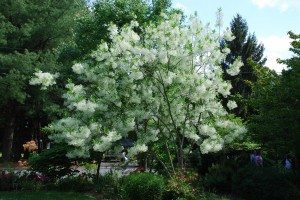Fringetree (Chionanthus virginicus) is treasured for its billowy masses of fragrant white flowers in the spring. It commonly grows as a large 15-20 foot tall shrub, but can be easily trained into a 20-25 foot multi-stemmed small tree.
Most gardeners call this native “fringe tree” or fringetree. Regionally, it goes by a number of colloquial names, including “grancy graybeard” (or grandpa’s graybeard) and “flowering ash”. The latter name refers to its close kinship with ash trees (Fraxinus spp.) and lilacs (Syringa spp.) which belong to the same plant family Oleaceae.
Fringetree blooms for nearly 3 weeks, from May into early June in the Southern Appalachian region (USDA hardiness zones 6 and 7). White fragrant flowers spring forth, just days ahead of its large bold textured foliage. The dark green leaves are 3 to 8 inches long and 3 to 4 inches wide, and remain blemish free all summer long.
Most fringetrees are seed propagated which leads to wide variation in fall color. Fall color can be an exceptional bright yellow in some years on particular plants. Others nearby may finish a plain yellowish green color before abcising.
Fringetree is dioecious, meaning flowers are mostly either male or female on the plant. Male flowering trees are said to produce larger showier flowers. The cultivar ‘Emerald’ is a male grafted clone. Female fringetrees bear powder blue fruits in late August. The seeds inside the fruits require 2 years to germinate. It is rare to find lots of seedlings growing in the wild.
Tight clay soils should be avoided and optimal growth occurs in slightly acidic soils. Fringetree grows best in full sunlight with plentiful flowers. In partial shade, the shrub gets tall and leggy, and produces fewer flowers.


 Posted in
Posted in 
